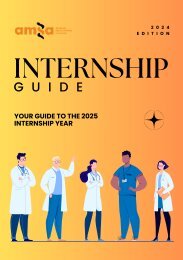Vector Volume 11 Issue 1 - 2017
You also want an ePaper? Increase the reach of your titles
YUMPU automatically turns print PDFs into web optimized ePapers that Google loves.
prevention method.[15] At-risk individuals can take one pill<br />
daily containing two antiretroviral medications, preventing<br />
replication of the virus within the body so that viral exposure<br />
is not seroconverted, thus preventing HIV infection.[16]<br />
Randomised control trials have found that ARVs taken as<br />
pre-exposure prophylaxis (PrEP) can prevent 40-99% of HIV<br />
infections when taken more than four times a week.[17-21]<br />
PrEP implementation trials are currently being run in New<br />
South Wales, Queensland, Victoria, South Australia, and<br />
the Australian Capital Territory. These trials are supported<br />
and funded by state health departments, allowing free or<br />
heavily discounted access to expensive drugs that cannot<br />
be accessed as PrEP via the Australian Pharmaceutical<br />
Benefits Scheme (PBS).[22]<br />
In New South Wales, the Kirby Institute runs the Expanded<br />
PrEP Implementation in Communities (EPIC) trial in<br />
conjunction with NSW Health. After a year of recruitment, over<br />
5000 at-risk individuals have been enrolled and given access<br />
to PrEP. Most of these participants are GBM, identified as<br />
being at high risk of HIV exposure.[13] This represents a major<br />
expansion from a small pilot study to a large demonstration<br />
trial.<br />
Are Indigenous gay and bisexual men accessing PrEP?<br />
Studies in the United States (US) have found that identified<br />
priority populations, including Black (African-American) men<br />
who have sex with men, may have difficulty in accessing PrEP<br />
compared to the general population. This may be due to lack<br />
of awareness about PrEP,[23] stigma,[24] poor healthcare<br />
coverage,[3] or lack of culturally-appropriate services<br />
providing access.[25] Indeed, Black men who have sex with<br />
men in the US were successfully recruited, engaged and<br />
retained in PrEP programs that employed “culturally-tailored<br />
techniques”.[26]<br />
Research shows that in order to target interventions<br />
like PrEP to Indigenous communities, culturally-appropriate<br />
services owned and governed by the community are in the<br />
best position to deliver positive health outcomes.[27-29]<br />
Likewise, health promotion materials should be designed and<br />
produced by the community for the community, and should<br />
avoid blocks of text and overly technical terminology.[30]<br />
Therefore, Aboriginal community-controlled health services<br />
(ACCHSs) may be best placed to help promote and educate<br />
PrEP to at-risk members of the community, facilitating<br />
referral to specialised sexual health clinics for assessment<br />
and preventative methods that may or may not include<br />
PrEP. ACCHSs provide holistic care, and are well equipped<br />
to focus on prevention and primary healthcare.[31] ACCHSs<br />
are considered manifestations of self-determination and<br />
autonomy for Indigenous communities.[29, 32]<br />
Self-determination in Indigenous Australian health<br />
services<br />
The United Nations has identified ACCHSs as best<br />
practice models of self-determination,[29] and the United<br />
Nations Declaration on the Rights of Indigenous Peoples<br />
advocates for the right of all peoples, especially Indigenous,<br />
to be able to “freely determine their political status and freely<br />
pursue their economic, social and cultural development”.<br />
[33] However, self-determination in healthcare alone cannot<br />
improve health outcomes. Secure, long-term funding coupled<br />
with equitable partnerships between Aboriginal communitycontrolled<br />
and mainstream health services is required to<br />
address the gap between Indigenous and non-Indigenous<br />
health.[29, 32] Facilitating community empowerment reduces<br />
the rates of HIV and STIs in female sex workers (FSWs)<br />
in low- and middle-income countries.[34, 35] Community<br />
empowerment in Australian FSWs during the initial years of<br />
the HIV epidemic was essential in enshrining effective HIV<br />
prevention focused on universal condom use among FSWs.<br />
[36] This case study could be applicable to the Indigenous<br />
population, and similar community empowerment in the<br />
form of well-funded ACCHSs may allow the gap between<br />
Indigenous and non-Indigenous health.<br />
Furthermore, Aboriginal Sexual Health Workers administer<br />
culturally-appropriate health services throughout Australia,<br />
increasing the involvement of Indigenous people in the<br />
healthcare workforce.[28, 37] However, Indigenous peoples<br />
need to be consulted and involved in the decision-making<br />
process and not just in the delivery of health services.[38, 39]<br />
Conclusion<br />
PrEP is touted as a crucial part of the HIV eradication<br />
strategy throughout the world. However, efforts to prevent HIV<br />
transmission may be hampered by a failure to engage priority<br />
populations, including Aboriginal and Torres Strait Islander<br />
Australians. PrEP implementation projects such as EPIC need<br />
to ensure adequate coverage of at-risk Indigenous peoples<br />
through culturally-appropriate health promotion and security<br />
of access to medication. This would be facilitated through<br />
the involvement of Indigenous Australians in the decisionmaking<br />
process. Further research will explore PrEP-related<br />
health promotion to Indigenous peoples and communities,<br />
and attempt to identify any gaps or facilitators.<br />
Figure 1. The age-standardised rate<br />
of new HIV notifications by Indigenous<br />
status.[8]<br />
30

















